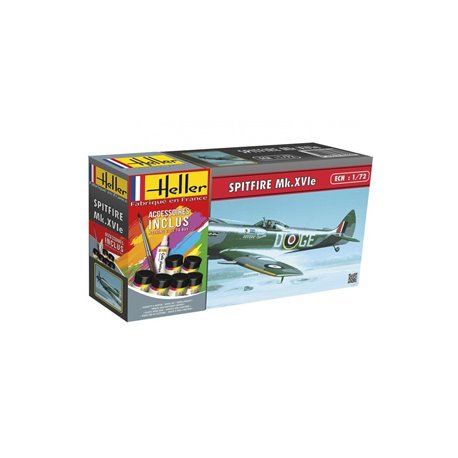No products
Product successfully added to your shopping cart
There are 0 items in your cart. There is 1 item in your cart.
 View larger
View larger Gift Set - Spitfire Mk XVI - 1/72 scale
HEL56282
Heller
Gift Set - Spitfire Mk XVI - 1/72 scale
- Parts: 35
- Dimensions: 13,3 x 13,8 cm
- This set includes paints, brushes and glue
This product is out of stock
More info
Gift Set - Spitfire Mk XVI - 1/72 scale
- Parts: 35
- Dimensions: 13,3 x 13,8 cm
- This set includes paints, brushes and glue
HISTORY
The Supermarine Spitfire is probably the most famous British fighter of the Second World War. It was an all-metal machine, in a low-wing configuration, with characteristic elliptical wings, classical tail-plane and retractable landing gear. The prototype was launched on 5 March 1936. The Spitfire proved to be the RAF's primary aircraft during the war and continued to perform successfully afterwards, remaining in production for 10 years. The Spitfire story began on the creel desk of R.J. Mitchell, the chief designer of the Supermarine company. The first Spitfires entered the RAF in 1938, but by the time the Battle of Britain began in the summer of 1940, 19 squadrons of modern fighters were already at the airfields - together with the slightly older Hurricane, 600 aircraft were defending the Isles. As the war progressed, the Spitfire saw service wherever the RAF operated - in the Far East, North Africa and Italy, the Normandy landings and the fighting in France, and finally during operations in Germany in 1945. For many British people it became a symbol of victory in the Second World War. This great machine lived to see at least a dozen production versions. The most important of these included the first mass-produced Spitfire Mk.I powered by the Rolls-Royce Merlin II 1030 hp engine. It was primarily this machine that made such an outstanding mark in the Battle of Britain. Many subversions of this model were developed, including PR Mk IA (reconnaissance version) or PR.IG (armed reconnaissance version). Another interesting version was the Spitfire Mk.V with a Rolls-Royce Merlin 45 engine producing 1440 hp. Serial production of this version began in 1941 and was the RAF's answer to the arrival of the Messerschmitt Bf-109F. Another very successful version was the Spitfire Mk.IX, powered by the Merlin 61 engine with a 4-blade flash. It was developed as a counter to the Focke-Wulf Fw-190 and entered production in late 1941. This version was modified several times and, for example, in 1944 it received a new gyro sight, enlarged rudder and a different wing arrangement. Another important version was the Spitfire Mk.XIV with the Rolls-Royce Griffon 61 engine, with a five-blade flash. Serial production began in October 1943. One of the last in series production was the Mk.21 version, which had the Griffon 61 engine, much strengthened structure and plating, and extended the wings to increase their flying area. The serial production started in March 1945. Technical data (Mk.XIV version): length: 9.14m, wing span: 11.23m, height: 3.05m, top speed: 717km/h, climb speed: 18.5m/s, practical ceiling: 13200m, maximum range: 1815km, armament: fixed - 4 machine guns cal.7.7mm and 2 cannons Hispano Mk II cal.20mm, suspended - up to 225kg of bombs.

